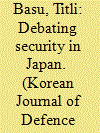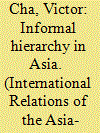|
|
|
Sort Order |
|
|
|
Items / Page
|
|
|
|
|
|
|
| Srl | Item |
| 1 |
ID:
162449


|
|
|
|
|
| Summary/Abstract |
Since the post–war era, understanding Japan’s security rhetoric and actions
presented certain incongruities. While the constructivist arguments underscore that
the influence of post–war antimilitarist norm shaped Japan’s security behavior, it
contradicts the realist underpinnings influencing Japan’s choices. To understand
Japanese post–war security orientation and comprehend the rapidly unfolding policy
shift, this paper explores three sets of questions: firstly, what are the competing
schools of thought in the Japanese security debate? What are their core arguments
on key issues including Article 9 of the Constitution, potency of the Self–Defense
Forces (SDFs), nature of the U.S.–Japan alliance and historical narratives of Japan’s
past? What are the inter-school and intra-school fault lines? Secondly, what are the
drivers that propelled the dominance of each school at different time frames? How
does the factional power struggle in the domestic political landscape enable each
school to maximize their space and influence in the current security discourse?
More specifically, why did mercantilists remained the dominant political force
throughout the Cold War? In contrast, what led to normalists gaining momentum
and substituting mercantilism as a potent force in the post–Cold War period?
Thirdly, how have political elites pursued their competing agendas and critically
analyze the case of Shinzo Abe? What are the influences that shaped his values?
What are the methods he employed to pursue his ambitions of making Japan a
“normal” nation? And how did he consolidate his political strength and manage to
realize concrete policy objectives?
|
|
|
|
|
|
|
|
|
|
|
|
|
|
|
|
| 2 |
ID:
155466


|
|
|
|
|
| Summary/Abstract |
The U.S.-based alliance system in Asia has grown stronger since the end of the Cold War, not weaker. Indeed, Japan and the Republic of Korea each celebrated in recent years the 60th anniversary of their alliances with the United States with proclamations of continued resiliency and longevity. Why is this? How do great powers maximize their influence in regional security? Some might argue that the threat of a rising China provides the glue to the alliances’ longevity. But no country in the region is really looking to balance China as the raison d’ȇtre of their security relationship with America. I argue the San Francisco system’s durability today is found in the unique origins of the hub and spokes alliance system. The United States operationalized a strategy of ‘tight bilateralism’ that maximized power through the creation of formal networks and informal hierarchy in Asia. It established a formal network of alliances to deter the communist threat, but also to exercise control over these newfound allies. The United States had bilateral relationships in Europe, where it transacted business through deep bilateral ties, as well as through a regional organization; moreover, some multilateral coordination among the member states was encouraged. This was less the case in Asia. Instead, a ‘hub and spokes’ arrangement emerged in which all parties in the network were plugged into a central hub, but with almost no interaction among them. This formal hub and spokes network operated as an informal hierarchical arrangement with Taiwan, South Korea, Japan, and others that maximized U.S. power. Moreover, the arrangement was legitimized domestically in all of the member states. This structure and process contributed greatly to the bilateral alliance arrangement’s continuing durability, even today. In this article, I focus on Japan as the primary example of this hierarchy strategy of ‘tight bilateralism’ at work.
|
|
|
|
|
|
|
|
|
|
|
|
|
|
|
|
|
|
|
|
|